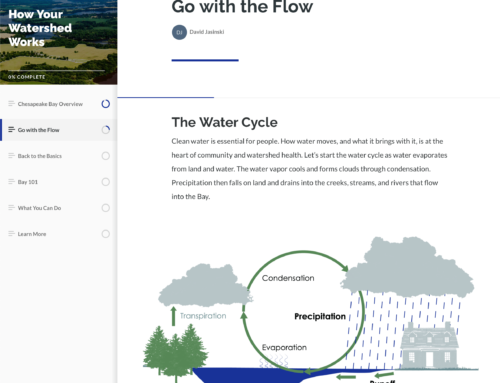 Climate change has been a hot topic of conversation for decades now – as we learn more about the science of our changing climate, there is more to communicate. At the end of last month, the Intergovernmental Panel on Climate Change (IPCC) released an updated report on impacts, adaptation, and vulnerability. It is their sixth report, with the first one occurring over 30 years ago in 1990. They reported that the situation is dire, and immediate action is needed. How do we generate the needed action?
Climate change has been a hot topic of conversation for decades now – as we learn more about the science of our changing climate, there is more to communicate. At the end of last month, the Intergovernmental Panel on Climate Change (IPCC) released an updated report on impacts, adaptation, and vulnerability. It is their sixth report, with the first one occurring over 30 years ago in 1990. They reported that the situation is dire, and immediate action is needed. How do we generate the needed action?
There are many challenges when it comes to communicating about climate change. The usual issues common to all science communication are still present: jargon, data visualization, confirmation bias, etc. Communicating about climate change specifically has additional complications, namely due to its long history and global nature. Through working on climate communication at the levels of a city, county, and region, the Green Fin Studio team has picked up a few best practices for strong climate communication.
1. Beating Burnout
When a serious issue is front and center for a long time, you risk your audience becoming emotionally, mentally, and even physically exhausted by the prolonged stress. This is colloquially called ‘burnout’. As mentioned earlier, the first IPCC report was released in 1990, over 30 years ago. That’s over three decades of hearing the warnings about climate change and, depending on who you ask, not seeing much forward movement. That can be frustrating, disheartening, and stressful.
Best practice: Include some positive information, not just the gloom and doom. To prevent burnout and keep your audiences engaged, we’ve learned that including something positive goes a long way. One way to do this is to celebrate the small wins. For example, share a positive news story about a small company experimenting with renewable energy as a counterpoint to a story about coral bleaching. Another way is to present paths forward after communicating the heavy climate information. This will leave your audience with a sense of empowerment or hope rather than having them mentally check out due to stress.
2. Sheer Scale
Climate change is often discussed as a global problem. In addition, to really talk about climate change, you need to cover hundreds of years of data. Both the spatial and temporal scale are too big to quickly wrap your head around, and we’ve found that many people are not interested in climate change as a global concept.
Best practice: Break this global issue that spans hundreds of years into bite-sized pieces, emphasizing everyday impacts. While climate change as a concept may not fully engage an audience, grounding the concept with personal stories or examples from the community grabs an audience’s attention. The impacts that people are seeing or will see within their communities can’t be ignored as easily as sea level rise is for a landlocked community. But droughts causing water shortages? More extreme weather that could damage the family home? These are the impacts that a community may care about. To make your communication products even stronger, consider having community members share their experience in the form of video interviews or written case studies.
Best practice: Create a tiered series of climate communication products. Some people in your audience will just want the quick, take-home messages. On the other end of the spectrum, some people will want to see the data itself and know where you got the data from. To accommodate all levels of interest and expertise, Green Fin Studio makes multiple products that can take a viewer deeper into the information. An infographic may lead to a 5-page executive summary that leads to a 170-page, full report. This kind of organization can also be seen in the products released by the IPCC; they have fact sheets, a 37-page summary for policymakers, a 96-page technical summary, and a full report with over 3,500 pages.
3. Overcoming Uncertainty
Data comes with uncertainty. Modeling comes with even more. Unfortunately, people can have a knee jerk reaction to the mention of uncertainty, and it can damage your credibility with an audience.
Best practice: Discuss uncertainty in other, more familiar terms. We accept varying levels of uncertainty and risk all of the time in our daily lives; thinking about uncertainty in this context may make it more palatable in the context of modeling as well. For example, when you select a plant for your garden, there is uncertainty about whether it will grow. When you order a meal at a restaurant, there is no guarantee that you will like it. Similar to a weather forecast that may be a little off sometimes, the information about what to expect is still useful even when there is some uncertainty.
Best practice: De-emphasize the modeling and uncertainty in favor of impacts already occurring. This practice ties in with the first best practice we mentioned: share the stories of community members who have experienced impacts from climate change. If you focus on the impacts that we are already seeing today (from a flooded home to a farmer’s lost crops), the discussion about whether we’ll see impacts in the future feels very certain.
We know that communicating about climate change is a challenge, and one we have no way around. By learning from our experiences and the experiences of others, we are able to navigate this issue using our tried-and-true best practices. Need help with climate communication? Contact us about being your creative and strategic partners in engineering a climate communication plan for your organization.
[pdf-embedder url=”https://greenfinstudio.com/wp-content/uploads/2022/03/Getting-Better.pdf” title=”Getting Better at CCC”]

